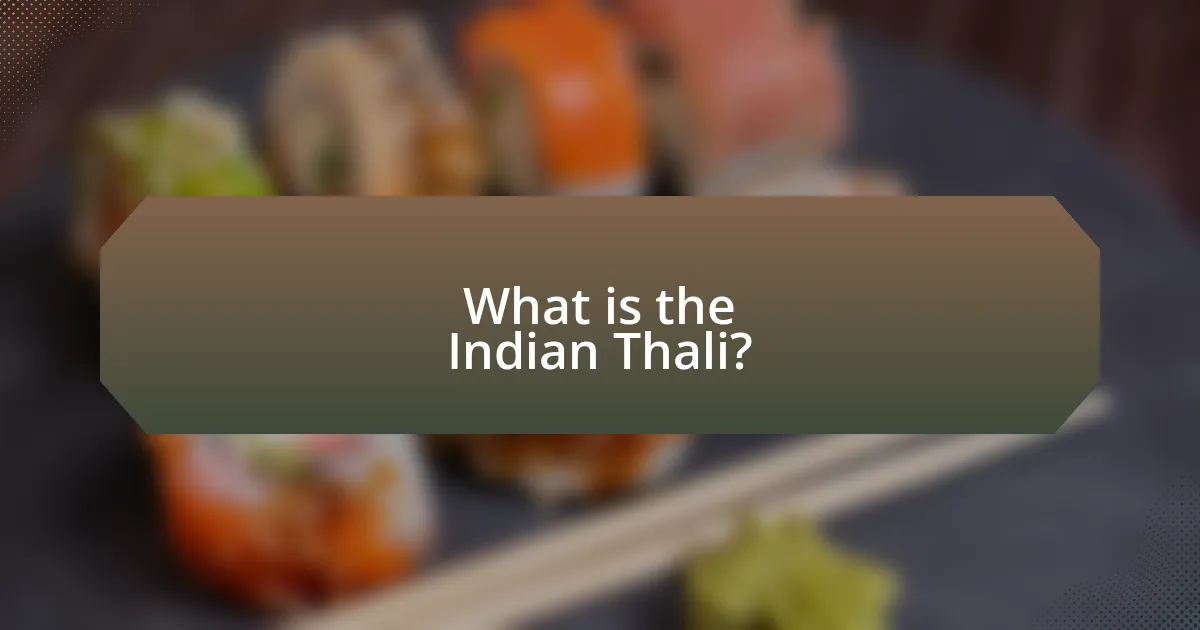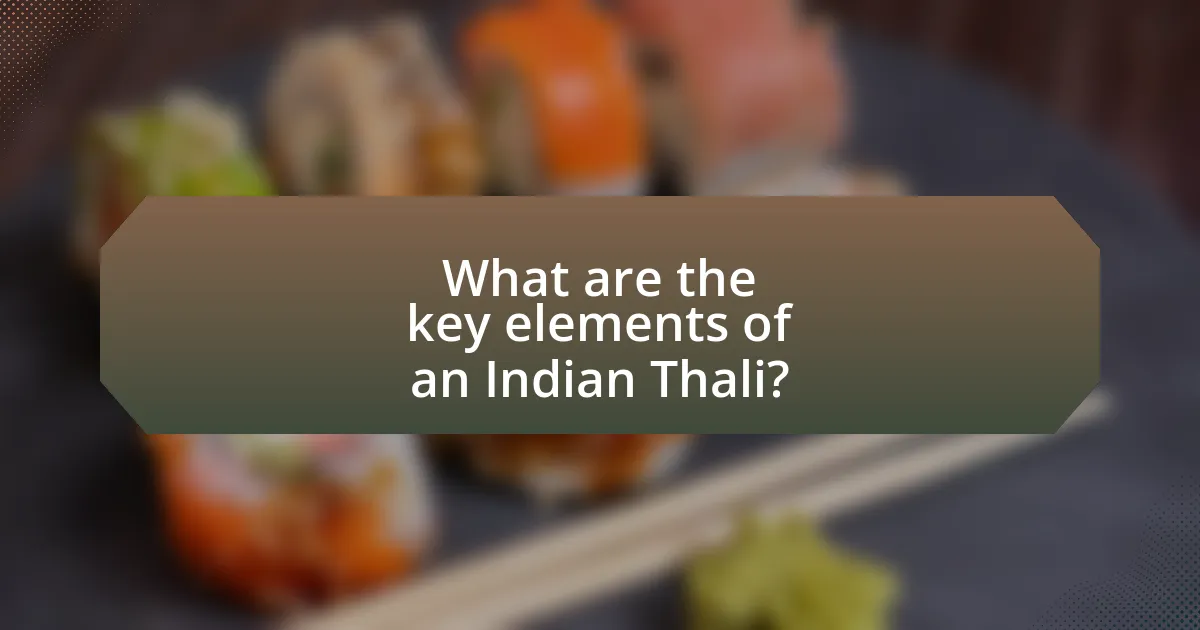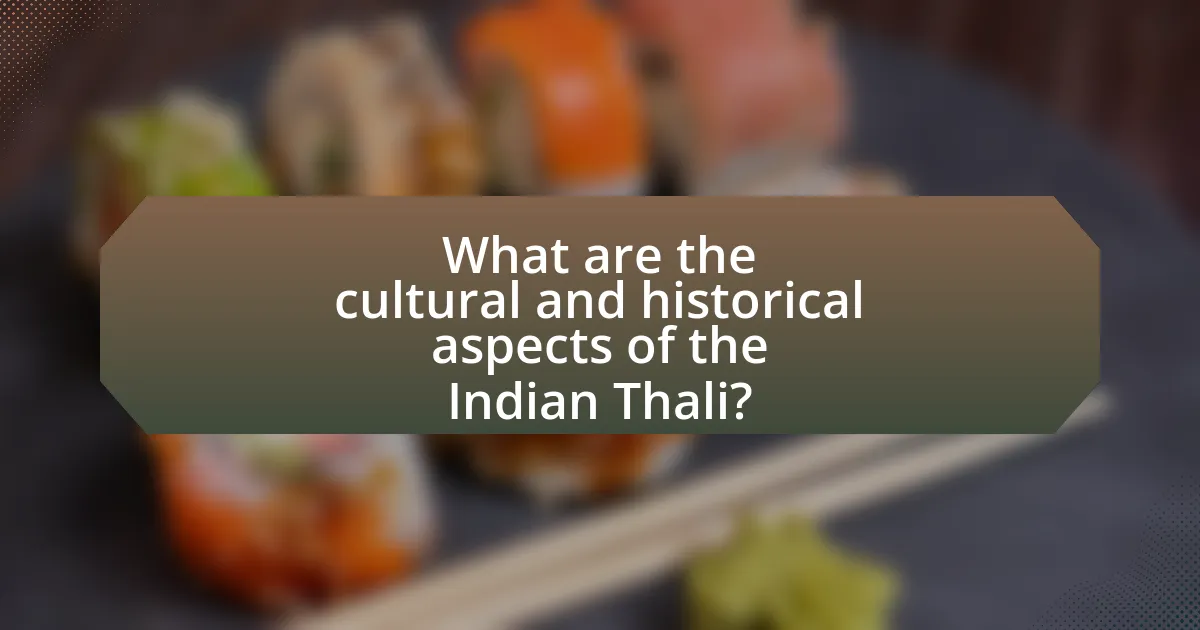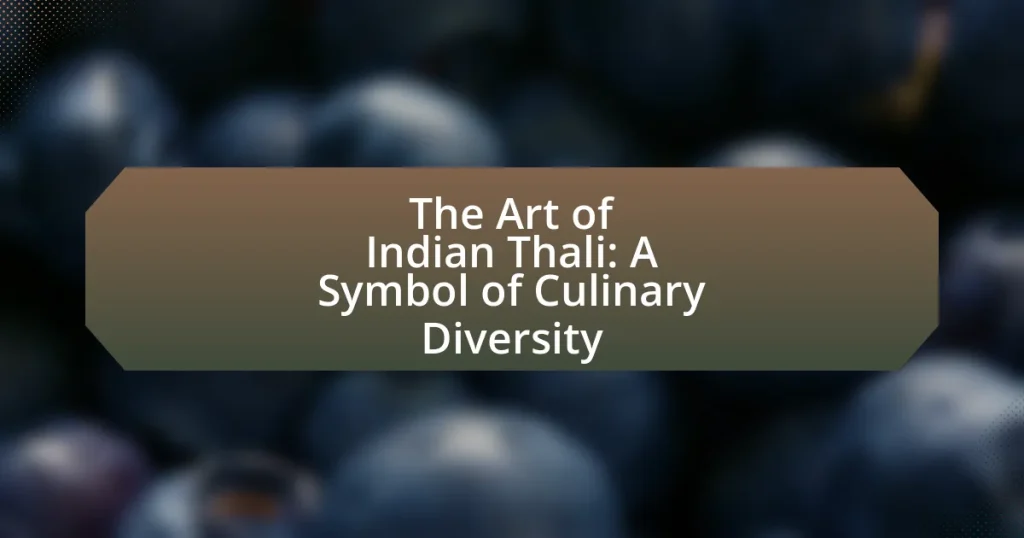The Indian Thali is a traditional meal presentation that features a variety of dishes served on a single platter, showcasing the rich culinary diversity of India. It typically includes staples such as rice, bread, lentils, vegetables, pickles, and desserts, reflecting regional variations and cultural significance. The article explores the components, presentation, and historical evolution of the Thali, highlighting its role in communal dining and its representation of India’s gastronomic landscape. Additionally, it discusses how cultural influences shape the ingredients used in Thalis and the emerging trends in their presentation within contemporary dining experiences.

What is the Indian Thali?
The Indian Thali is a traditional meal presentation that consists of a variety of dishes served on a single platter. This culinary format typically includes staples like rice and bread, accompanied by an assortment of vegetables, lentils, pickles, and sometimes meat or fish, reflecting the diverse regional cuisines of India. The Thali not only showcases the rich flavors and textures of Indian food but also emphasizes the cultural significance of communal dining, where multiple dishes are enjoyed together, enhancing the overall dining experience.
How is the Indian Thali defined in culinary terms?
The Indian Thali is defined as a traditional meal presentation that consists of a variety of dishes served on a single platter. This culinary format typically includes staples such as rice, bread, lentils, vegetables, and accompaniments like pickles and yogurt, showcasing regional diversity and flavors. The Thali reflects India’s rich culinary heritage, as it varies significantly across different states, incorporating local ingredients and cooking techniques. For instance, a North Indian Thali may feature paneer dishes and chapatis, while a South Indian Thali often includes rice and sambar, illustrating the regional adaptations within this meal structure.
What are the traditional components of an Indian Thali?
The traditional components of an Indian Thali typically include rice, various types of bread (such as roti or naan), lentils (dal), vegetables (sabzi), pickles (achar), yogurt (raita), and a sweet dish (dessert). Each component represents a balance of flavors and nutrients, showcasing the diversity of Indian cuisine. For instance, rice serves as a staple carbohydrate, while dal provides protein, and vegetables contribute essential vitamins and minerals. This variety not only reflects regional culinary practices but also emphasizes the cultural significance of sharing meals in Indian society.
How does the presentation of an Indian Thali enhance its appeal?
The presentation of an Indian Thali enhances its appeal by showcasing a vibrant array of colors, textures, and flavors that reflect the culinary diversity of India. This visual appeal is achieved through the careful arrangement of various dishes, such as curries, breads, and desserts, on a single platter, which invites diners to explore different tastes in one meal. The use of traditional serving utensils and decorative elements further elevates the dining experience, making it not just a meal but a feast for the senses. Studies have shown that visually appealing food can increase appetite and enjoyment, reinforcing the idea that the aesthetic presentation of an Indian Thali plays a crucial role in enhancing its overall appeal.
Why is the Indian Thali considered a symbol of culinary diversity?
The Indian Thali is considered a symbol of culinary diversity because it showcases a wide array of regional dishes, flavors, and cooking techniques from across India. Each Thali typically includes multiple components such as rice, bread, lentils, vegetables, pickles, and desserts, reflecting the rich cultural heritage and local ingredients of different states. For instance, a North Indian Thali may feature paneer dishes and chapatis, while a South Indian Thali often includes rice, sambar, and coconut chutney. This variety not only highlights the distinct culinary traditions but also emphasizes the use of diverse spices and cooking methods, making the Thali a comprehensive representation of India’s gastronomic landscape.
What regional variations exist within Indian Thalis?
Indian Thalis exhibit significant regional variations, reflecting the diverse culinary traditions across the country. For instance, a North Indian Thali typically includes items like roti, dal, sabzi, and rice, often accompanied by pickles and yogurt, emphasizing wheat-based dishes. In contrast, a South Indian Thali features rice as the staple, served with sambar, rasam, and various chutneys, highlighting the use of lentils and coconut.
Additionally, a Gujarati Thali is characterized by its sweet and savory balance, often including dishes like dhokla and thepla, while a Bengali Thali showcases fish and rice, with mustard oil and spices being predominant. These variations are rooted in local ingredients, cultural practices, and historical influences, making each Thali a unique representation of its region’s culinary identity.
How do cultural influences shape the ingredients used in an Indian Thali?
Cultural influences significantly shape the ingredients used in an Indian Thali by reflecting regional traditions, religious practices, and historical interactions. For instance, the use of lentils and rice in various forms is prevalent due to agrarian practices across India, while spices like turmeric and cumin are integral due to their medicinal and preservative properties rooted in Ayurvedic traditions. Additionally, the incorporation of ingredients such as coconut in South Indian Thalis and mustard oil in Bengali Thalis showcases regional agricultural availability and culinary preferences. Historical influences, such as the Mughal era, introduced rich gravies and aromatic spices, further diversifying the Thali’s composition. Thus, the Indian Thali serves as a culinary representation of the country’s diverse cultural landscape, shaped by geography, history, and social customs.

What are the key elements of an Indian Thali?
An Indian Thali typically consists of a variety of dishes served on a single platter, showcasing the diversity of Indian cuisine. Key elements include rice, various types of bread (such as roti or naan), lentils (dal), vegetables (sabzi), pickles, yogurt (raita), and a sweet dish (dessert). Each component represents different flavors and textures, reflecting regional culinary traditions across India. The inclusion of these elements not only provides a balanced meal but also highlights the cultural significance of communal dining in Indian society.
What types of dishes are typically included in an Indian Thali?
An Indian Thali typically includes a variety of dishes such as dal (lentils), sabzi (vegetable curry), rice, roti (flatbread), pickles, raita (yogurt-based side), and a sweet dish. Each component represents different flavors and textures, showcasing the culinary diversity of Indian cuisine. For instance, dal provides protein, while sabzi offers essential vitamins from vegetables. The inclusion of rice and roti serves as staple carbohydrates, and raita adds a cooling effect to balance spices. This assortment reflects regional variations, with specific dishes varying by locality, thus emphasizing the rich tapestry of Indian culinary traditions.
How do vegetarian and non-vegetarian Thalis differ?
Vegetarian and non-vegetarian Thalis differ primarily in their protein sources and dish composition. A vegetarian Thali typically includes a variety of plant-based dishes such as lentils, vegetables, rice, and bread, while a non-vegetarian Thali features meat or fish as the main protein, accompanied by similar side dishes. For example, a vegetarian Thali may consist of dal (lentils), sabzi (vegetable curry), and roti (bread), whereas a non-vegetarian Thali might include chicken curry or fish fry alongside rice and salad. This distinction highlights the culinary diversity within Indian cuisine, catering to different dietary preferences and cultural practices.
What role do accompaniments like chutneys and pickles play in a Thali?
Accompaniments like chutneys and pickles play a crucial role in a Thali by enhancing flavor, providing contrast, and balancing the meal. These condiments introduce a variety of tastes, such as sweet, sour, and spicy, which complement the main dishes and elevate the overall dining experience. For instance, chutneys made from ingredients like mint or tamarind can add freshness or tanginess, while pickles made from seasonal vegetables can offer a sharp, piquant flavor. This diversity in taste not only stimulates the palate but also reflects the regional culinary traditions of India, showcasing the rich variety of ingredients and preparation methods used across different cultures.
How does the Indian Thali reflect the philosophy of Indian cuisine?
The Indian Thali reflects the philosophy of Indian cuisine by embodying the principles of balance, variety, and harmony. This traditional meal consists of multiple dishes served on a single platter, showcasing a diverse range of flavors, textures, and nutritional components. Each element, from lentils to vegetables and breads, is carefully selected to create a holistic dining experience that emphasizes the importance of moderation and the use of seasonal ingredients. The Thali not only represents regional culinary practices but also highlights the cultural significance of sharing food, reinforcing community and togetherness in Indian society.
What is the significance of balance and variety in an Indian Thali?
The significance of balance and variety in an Indian Thali lies in its representation of nutritional completeness and cultural diversity. An Indian Thali typically includes a range of dishes that provide essential nutrients, such as carbohydrates, proteins, vitamins, and minerals, ensuring a balanced meal. For example, the inclusion of lentils (dal) offers protein, while vegetables contribute vitamins and fiber. Additionally, the variety in flavors and textures—from spicy curries to sweet desserts—reflects the rich culinary traditions across different regions of India, showcasing local ingredients and cooking techniques. This diversity not only enhances the dining experience but also symbolizes the unity in India’s cultural plurality, making the Thali a holistic representation of Indian gastronomy.
How does the Thali promote communal dining and sharing?
The Thali promotes communal dining and sharing by presenting a variety of dishes on a single platter, encouraging diners to serve themselves and share food with others. This format fosters a sense of togetherness, as multiple people can enjoy different flavors and textures simultaneously, enhancing the social experience of the meal. The tradition of sharing food from a common Thali is rooted in Indian culture, where meals are often seen as a communal activity, reinforcing bonds among family and friends. Additionally, the practice of passing dishes around and sampling each other’s selections creates an interactive dining experience that emphasizes community and connection.

What are the cultural and historical aspects of the Indian Thali?
The Indian Thali represents a rich tapestry of cultural and historical significance, reflecting the diverse culinary traditions across India. Historically, the Thali has roots in ancient Indian dining practices, where communal eating was emphasized, symbolizing unity and sharing among family and friends. The variety of dishes served on a Thali showcases regional ingredients and cooking techniques, illustrating the geographical and cultural diversity of India. For instance, a North Indian Thali may include items like roti, dal, and paneer, while a South Indian Thali features rice, sambar, and rasam, highlighting local agricultural produce and culinary customs. The Thali also embodies the principles of Ayurveda, promoting a balanced diet through the inclusion of various flavors and nutrients, which has been a part of Indian culture for centuries. Thus, the Indian Thali is not just a meal but a representation of India’s historical evolution, social values, and culinary heritage.
How has the Indian Thali evolved over time?
The Indian Thali has evolved significantly over time, reflecting regional diversity and historical influences. Initially, the Thali consisted of simple, staple foods that varied by region, such as rice, lentils, and vegetables, influenced by local agricultural practices. As trade routes expanded and cultural exchanges occurred, the Thali incorporated a wider variety of ingredients and cooking techniques, including spices from the Middle East and flavors from colonial influences.
In contemporary times, the Thali has become a representation of culinary diversity, often featuring a balanced assortment of dishes, including curries, breads, pickles, and desserts, showcasing the rich heritage of Indian cuisine. This evolution is evidenced by the increasing popularity of Thali in restaurants, where it is presented as a complete meal, emphasizing both traditional and modern interpretations.
What historical events have influenced the development of the Thali?
The development of the Thali has been influenced by several historical events, including the Mughal Empire’s culinary innovations and the British colonial period’s introduction of new ingredients. The Mughal Empire, which flourished from the 16th to the 19th centuries, brought Persian and Central Asian influences, leading to the incorporation of rich gravies, aromatic spices, and diverse cooking techniques into Indian cuisine. This period saw the emergence of dishes like biryani and kebabs, which became integral to the Thali. Additionally, during the British colonial era, the introduction of new vegetables, fruits, and cooking methods further diversified the Thali, allowing for regional variations and adaptations that reflect local tastes and ingredients. These historical influences have shaped the Thali into a representation of India’s culinary diversity, showcasing a blend of flavors and traditions.
How do festivals and celebrations impact the composition of a Thali?
Festivals and celebrations significantly influence the composition of a Thali by introducing specific dishes that are culturally and regionally significant to the occasion. For example, during Diwali, sweets like Gulab Jamun and savory snacks such as Samosas are commonly included, reflecting the festive spirit and traditional practices associated with the holiday. Similarly, during Pongal, rice dishes flavored with jaggery and coconut are prevalent, showcasing local agricultural produce and customs. These variations in the Thali not only highlight the diversity of Indian cuisine but also reinforce cultural identity and communal bonds during celebrations.
What role does the Indian Thali play in modern dining experiences?
The Indian Thali serves as a central element in modern dining experiences by showcasing the rich diversity of Indian cuisine in a single meal. This traditional platter typically includes a variety of dishes, such as curries, lentils, vegetables, rice, and bread, allowing diners to experience multiple flavors and textures simultaneously. The Thali not only promotes communal dining, encouraging sharing and interaction among guests, but also reflects regional culinary practices, making it a representation of India’s cultural heritage. Furthermore, the rise of health-conscious dining has led to the Thali being appreciated for its balanced nutrition, as it often incorporates a range of food groups.
How are Indian Thalis adapted in contemporary restaurants?
Indian Thalis are adapted in contemporary restaurants by incorporating regional variations, modern plating techniques, and fusion elements. Many restaurants now offer Thalis that feature a mix of traditional dishes from different Indian states, allowing diners to experience a broader spectrum of flavors in one meal. Additionally, contemporary establishments often present Thalis in a visually appealing manner, using stylish serving ware and artistic arrangements to enhance the dining experience. Some restaurants also introduce fusion dishes that blend Indian flavors with international cuisines, catering to diverse palates while maintaining the essence of the Thali concept. This evolution reflects the growing trend of culinary innovation while honoring the traditional roots of Indian cuisine.
What trends are emerging in the presentation and serving of Thalis?
Emerging trends in the presentation and serving of Thalis include a focus on sustainability, artistic plating, and regional diversity. Restaurants are increasingly using eco-friendly materials for serving Thalis, such as banana leaves or biodegradable plates, reflecting a commitment to environmental responsibility. Additionally, chefs are adopting innovative plating techniques that enhance visual appeal, often incorporating vibrant colors and textures to create an aesthetically pleasing experience. Furthermore, there is a growing emphasis on showcasing regional specialties within Thalis, allowing diners to explore the culinary diversity of India through carefully curated selections that highlight local ingredients and traditional cooking methods. These trends are reshaping how Thalis are experienced, making them not only a meal but also a celebration of culture and sustainability.
What are some tips for creating an authentic Indian Thali at home?
To create an authentic Indian Thali at home, focus on incorporating a variety of dishes that represent different regions of India. A traditional Thali typically includes a balance of flavors and textures, featuring items such as dal (lentils), sabzi (vegetable curry), rice, roti (flatbread), pickles, and a sweet dish.
Ensure that the ingredients are fresh and use traditional spices like cumin, coriander, and turmeric to enhance the authenticity. For example, using ghee instead of oil can elevate the flavor profile. Additionally, serving the Thali on a stainless steel or brass plate adds to the authenticity, as these materials are commonly used in Indian households.
By including regional specialties, such as a South Indian sambar or a North Indian paneer dish, you can showcase the culinary diversity of India. This approach not only creates a visually appealing meal but also provides a comprehensive taste experience that reflects the cultural richness of Indian cuisine.
